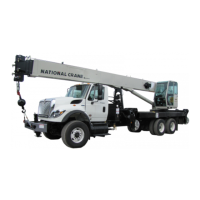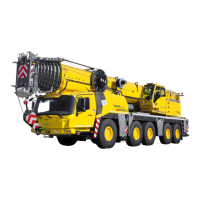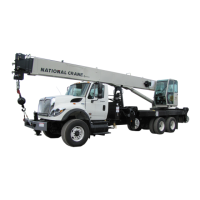Manitowoc Published 12-05-17, Control # 035-23 1-41
18000 SERIVCE/MAINTENANCE MANUAL INTRODUCTION
Boom Hoist Lower
When boom hoist control handle is moved forward for
booming down, an input voltage of 2.6 volts or more is sent
to node-1 controller. Node-5 controller sends a variable zero
to 24 volt output that is divided by a resistor and applied to
each boom pump EDC. Node-6 controller sends a variable
zero to 24 volt output that is divided by a resistor and applied
to each boom motor PCP. Node-1 controller checks that
boom up limit switch is closed and no hydraulic system fault
is present.
Each pump EDC tilts swashplate in the up direction to satisfy
pressure memory. Node-1 controller compares boom hoist-
holding pressure to value in pressure memory. When system
pressure is high enough, node-6 controller sends a 24 volt
output to boom hoist brake solenoid valve HS-6. The brake
solenoid shifts to block drain port and opens port to low-
pressure side of boom hoist system to release boom hoist
drum brake.
When brake is released, each pump EDC continues to tilt
swashplate to stroke pumps in the down direction. In the
down direction, hydraulic fluid flow is from pump ports to
motor ports. Return fluid is from motor outlet ports to pump
inlet ports.
Node-5 controller output voltage to each pump EDC and
node-6 controller output voltage to each motor PCP is
relative to control handle movement. As boom hoist control
handle is pushed forward, pump swashplate angle is
increased. When system pressure exceeds the PCOR
(Pressure Compensating Over-Ride) valve setting of 4,930
psi (340 bar), the valve shifts to direct flow from shuttle valve
into maximum displacement side of servo cylinder. The
PCOR valve over-rides the command from servo PC valve,
increasing motor displacement and output torque and
reducing output speed. When PCOR valve closes, control of
the motor returns to servo PC valve.
Node controllers are continuously balancing the system
pressure and the motor displacement angle so the motor
displacement goes to minimum when control handle is fully
forward, if the motor torque requirement is not too high.
Node-1 controller monitors motor displacement and controls
motor speed by regulating the hydraulic fluid flow through the
pump.
The weight of boom attempts to drive motor faster than
return fluid can return to low-pressure side of pump. System
charge pump maintains fluid supply at a positive pressure to
motor. Pump swashplate position restricts the returning fluid
flow. Pressure builds on fluid return side of closed-loop,
acting as a hydraulic brake to control lowering speed.
When boom hoist control handle is moved to neutral
position, node-1 controller compensates for hydraulic
system leakage or changing engine speed. Node-5
controller sends a zero output voltage to each boom hoist
pump EDC that moves swashplate to center position. This
shifts the motors back to maximum displacement for slower
output speed to slow the drum rotation. Node-1 controller
stores the load holding pressure in pressure memory. After
control handle center switch opens, Node-6 controller sends
a zero output to disable boom hoist brake solenoid valve HS-
6. Drum brake solenoid valve shifts to block pilot pressure to
brakes and opens a line to tank. Brakes apply before drum
pump de-strokes.
